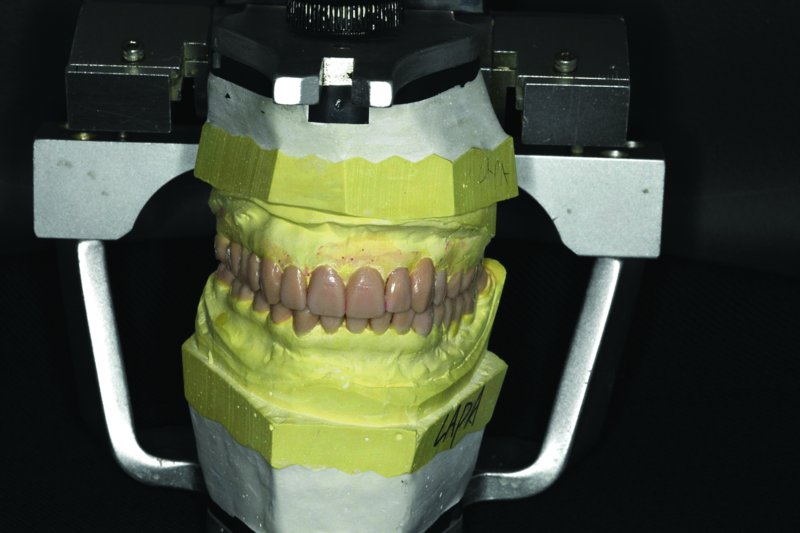Planning for Porcelain Laminate Veneers
Christopher C.K. Ho
Principles
Treatment Planning
A comprehensive examination with a complete history and clinical assessment is a critical step in this treatment modality. The prevention of disease and control should be considered a first priority, with planning for aesthetic improvement such as veneers considered after this has been completed.
The treatment planning begins with the following:
- Discussion of a patient’s objectives and the ability of the dentist to achieve the desired outcomes.
- Initial examination. A systematic approach documenting clinical findings, including periodontal conditions, existing restorations, occlusion and so on. A radiographic examination and study models should complete this initial examination. A photographic series of the patient including extra-oral photos of the full smile and lateral smiles as well as intra-oral photos should be part of the documentation process.
- Informed consent. With the information gathered, discussions should be held to inform the patient fully about the treatment. This should be done in a simple manner, detailing the treatment steps and limitations of treatment. Care must be exercised not to over-promise the final outcomes, and also to determine whether the patient is expecting unachievable results.
It must be remembered that as health professionals we abide by Primum non nocere, a Latin phrase that means ‘First, do no harm’. If a patient can be treated with conservative options, then this must be discussed and recommended to patients as part of the treatment planning process.
Here are some examples:
- Crooked teeth and diastemas may be treated with orthodontic treatment, which would be advantageous, as there would be no preparation of teeth or long-term replacement required. Orthodontics may also be a phase of treatment to position the teeth prior to veneers, allowing for less invasive preparation. The introduction of new orthodontic techniques like Invisalign™ may help to remove some of the objections to conventional orthodontics.
- Discoloured teeth might be bleached with vital bleaching or, in the case of a discoloured non-vital tooth, a non-vital ‘walking’ bleach may be carried out.
- Small chips on teeth might be restored with direct resin.
7.1.1.2 Indications for Porcelain Veneers 1
- Type I – Teeth resistant to bleaching:
- Tetracycline discoloration.
- No response to external or internal bleaching.
- Type II – Major morphologic modifications:
- Conoid teeth.
- Diastema and interdental triangles to be closed.
- Augmentation of incisal length and prominence.
- Type III – Extensive restoration:
- Extensive coronal fracture.
- Extensive loss of enamel by erosion and wear.
- Generalised congenital and acquired malformations.
Contraindications for Veneers
- Minimal enamel for bonding.
- Major changes in tooth colour.
- Major changes in tooth positions, such as severe crowding.
- Large restorations within tooth, minimal enamel and reduced tooth rigidity.
- Bruxism (unprotected) or other parafunctional habits, for instance pen chewing, ice crushing.
- Psychological.
Diagnostic Wax-Up or Mock-Up
Utilisation of a diagnostic wax-up (Figure 7.1.1) can help plan the desired aesthetic appearance. This should incorporate the patient’s wants that were expressed in the initial treatment planning discussions.

Figure 7.1.1 Diagnostic wax-up on articulated models
The diagnostic wax-up provides visualisation of the desired treatment and a blueprint of the final restorations. Additionally, a wax-up allows the fabrication of putty keys for provisionalisation and reduction guides for the preparation process. The contours and form of the final teeth can be transferred from the desired wax-up to the provisionals, allowing the patient to have a preview of their desired appearance and to re-confirm that they are happy with the planned changes. It is certainly advantageous for a patient to view the changes prior to constructing the veneers, due to the cost of re-making restorations if patients are not happy.
Material Choices
There are different types of ceramics available to fabricate veneers, but there are two basic types of materials used: low-fusing feldspathic porcelain and lithium disiliate or leucite-reinforced ceramics.
Feldspathic Porcelain
This is also referred to as powder liquid or stacked veneers. It is used in the layering or build-up technique of most modern porcelains. This material contains mainly silica
Stay updated, free dental videos. Join our Telegram channel

VIDEdental - Online dental courses


